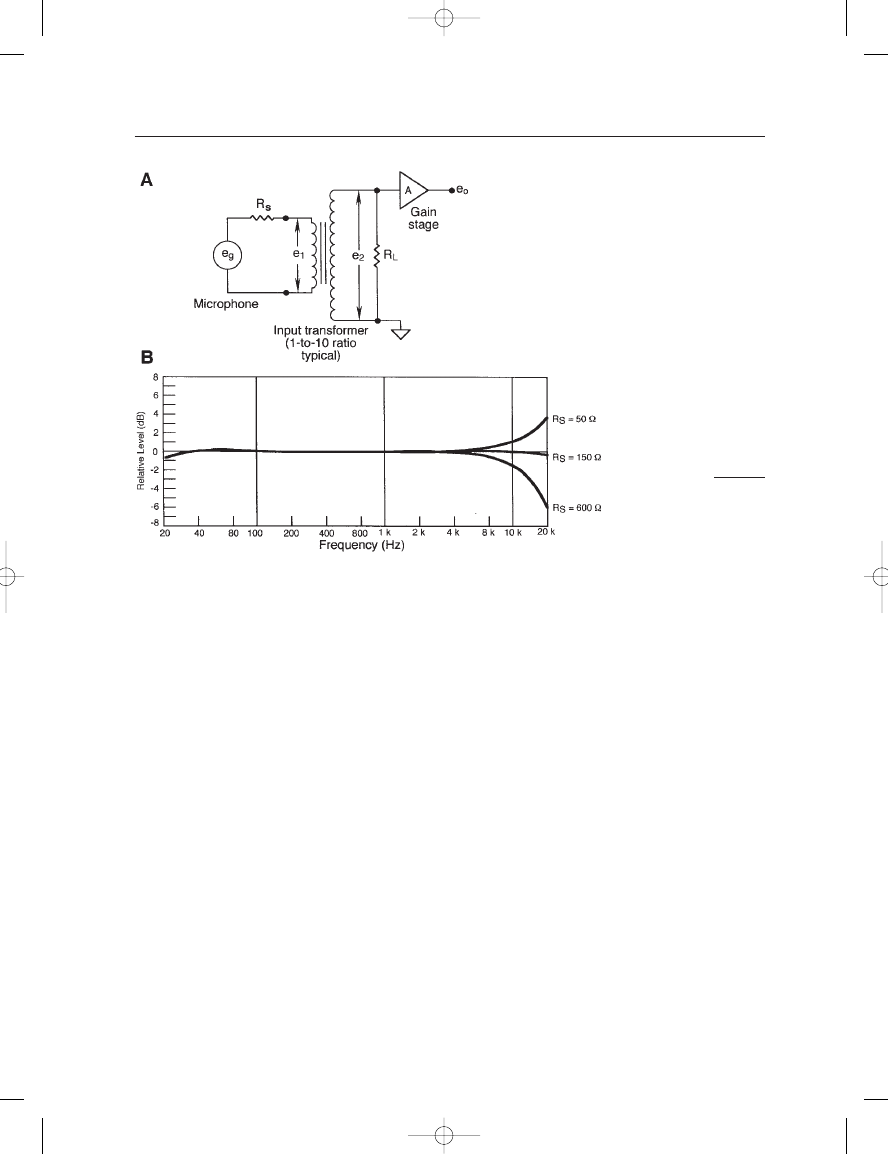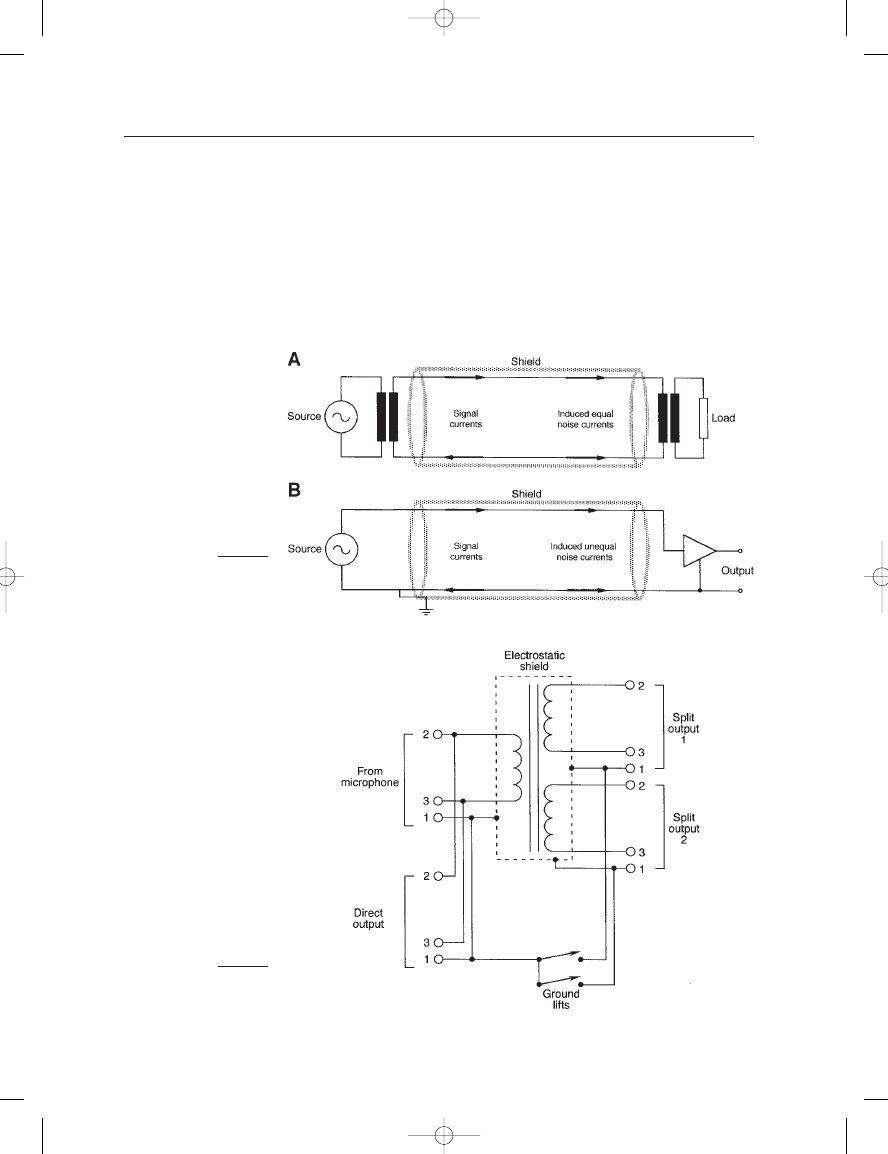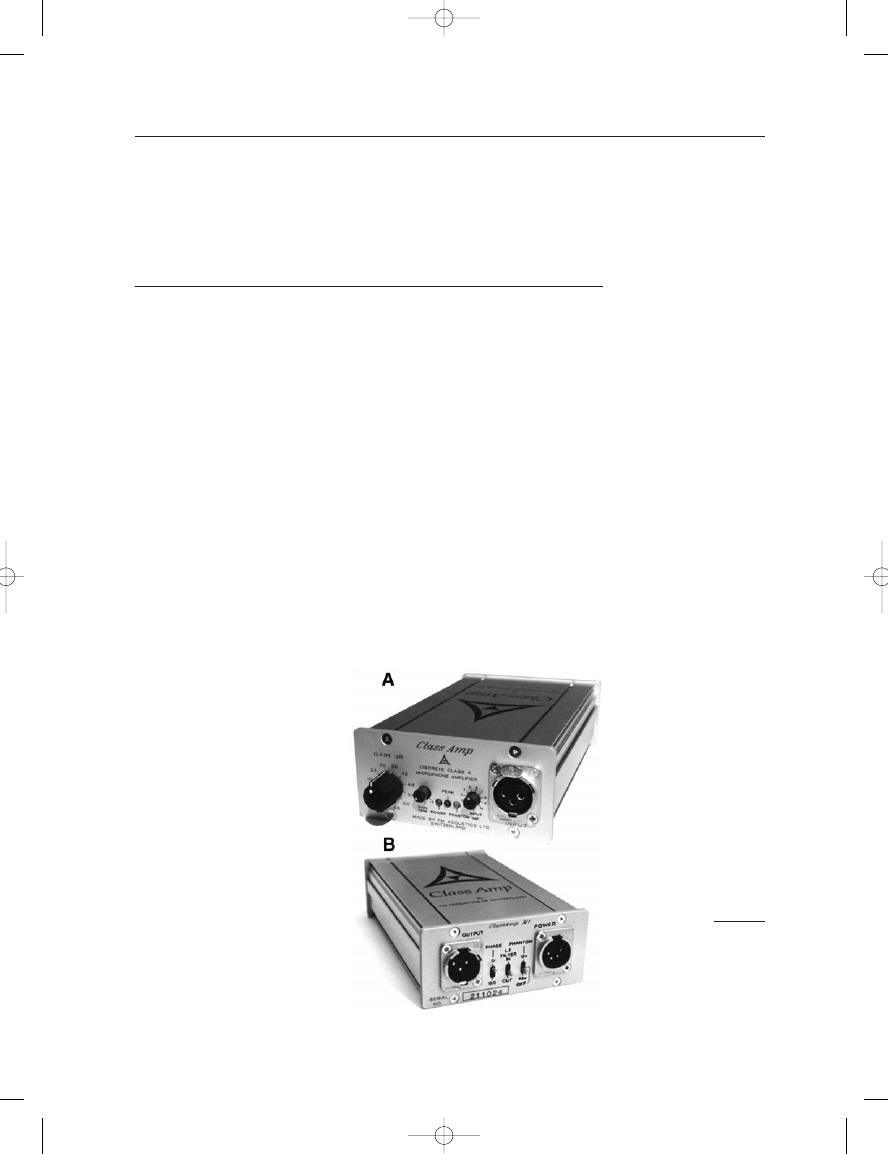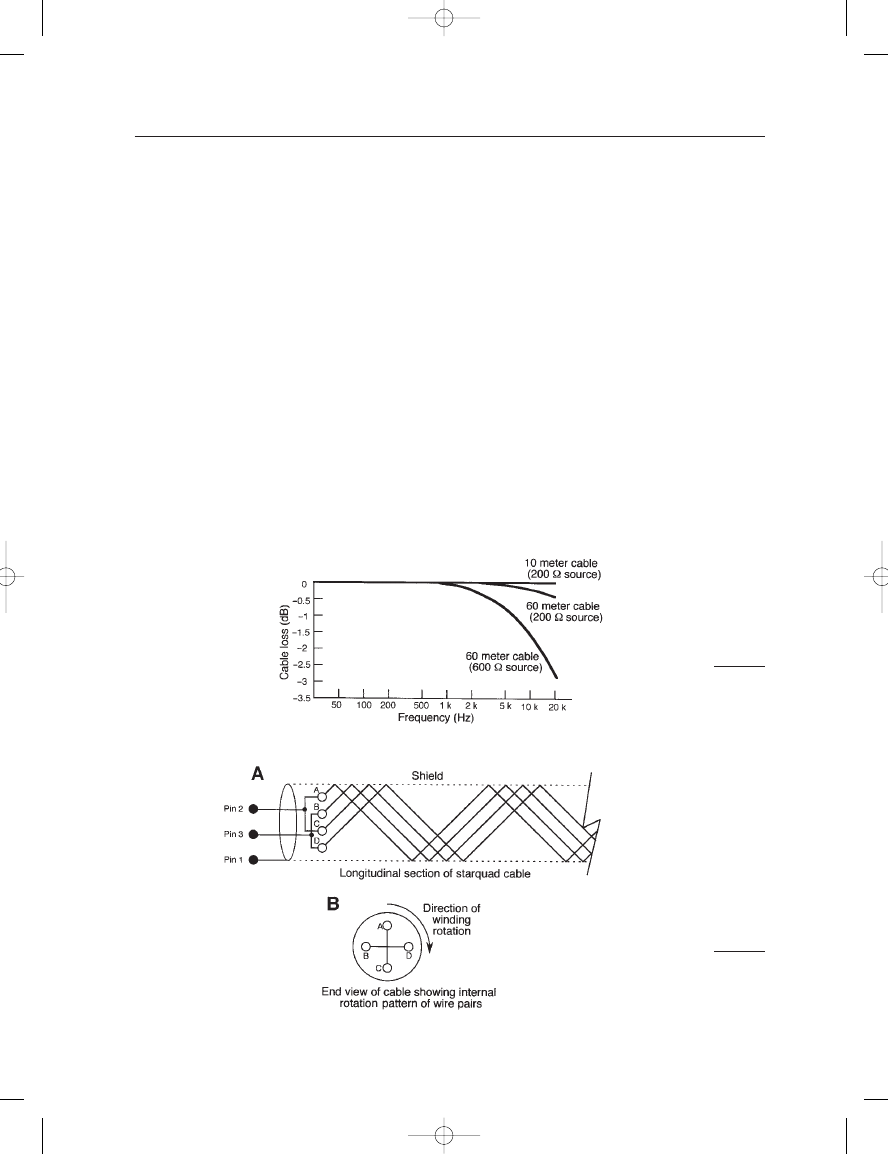ВУЗ: Казахская Национальная Академия Искусств им. Т. Жургенова
Категория: Книга
Дисциплина: Не указана
Добавлен: 03.02.2019
Просмотров: 17284
Скачиваний: 51

Another problem with improper loading is shown in Figure 8–13.
Here, a capacitor microphone is loaded by a console input transformer
that has a non-optimal termination on its secondary side. This can pro-
duce response variations similar to those shown in the figure as a func-
tion of the microphone’s output impedance. Note that as the input
impedance is reduced, the response develops a rise in the 10 kHz range.
This comes as a result of an undamped resonance involving the stray
capacitance between the primary and secondary windings of the trans-
former (Perkins, 1994).
UNBALANCED MICROPHONE INPUTS
Only in the lowest cost paging systems is one likely to come across an
unbalanced microphone input. For fairly short cable runs from micro-
phone to amplifier, there may be no problems. For longer runs, where
there is greater likelihood for interference, the difference between balanced
and unbalanced operation is as shown in Figure 8–14. For balanced oper-
ation, shown at A, induced noise will be equal and in-phase in both signal
leads; it will be effectively canceled by the high common mode rejection
of the input circuitry. For unbalanced operation, shown at B, the induced
signal currents will be different between shield and conductor, and the
noise will be significant.
THE MICROPHONE BOOK
128
FIGURE 8–13
Response of transformer
input circuit to varying
values of microphone
source impedance.
Earg_08.qxd 14/9/04 2:45 PM Page 128

MICROPHONE SPLITTERS
For many field operations, stage microphones must be fed to both record-
ing and sound reinforcement activities. Microphone splitters are used to
provide both an electrically direct feed to one operation, normally the
recording activity, and a one-to-one transformer feed to the other activity.
Circuit details for a typical passive splitter are shown in Figure 8–15. Here,
there are two secondary windings, providing an additional output for
broadcast activities. Ground lifts are often used to avoid hum due to
8: Electrical Considerations and Electronic Interface
129
FIGURE 8–14
Balanced (A) versus
unbalanced (B) microphone
operation.
FIGURE 8–15
Details of a passive
microphone splitter.
Earg_08.qxd 14/9/04 2:45 PM Page 129

ground loops. When using passive splitters, it is essential that all loads
fed by the splitter be bridging. Active splitters are often used in order to
avoid expensive transformers and to permit feeding the signal to low
input impedance loads.
THE STAND-ALONE MICROPHONE PREAMP
Many leading recording engineers prefer to bypass console microphone
inputs altogether and use multiple individual stand-alone microphone
preamps instead. These microphone preamps are normally highly refined
versions of what may be found in the typical console, some offering sig-
nificant improvements in areas of noise floor, common mode rejection,
increased output level capability, source impedance matching, calibrated
step-type gain trim, and rugged construction. Other features in some
models include equalization options and metering. These performance
attributes do not come cheaply, and a set of 16 individual preamps may
cost many times more than an excellent mass-produced 24-input console.
For many recording activities it may be difficult to justify the expense
of stand-alone preamps, considering that their outputs will be fed into a
host console for normal signal routing and bus assignment. However,
there are specific applications where their use is appropriate:
●
Direct-to-stereo via two microphones, where no console routing
functions are needed.
●
Pop multichannel recording, with each microphone assigned to one
recording channel. Here, the local host console is relegated to control
THE MICROPHONE BOOK
130
FIGURE 8–16
Front (A) and back
(B) views of a stand-alone
microphone preamplifier.
(Figure courtesy of FM
Acoustics.)
Earg_08.qxd 14/9/04 2:45 PM Page 130

room and studio monitoring only, with all studio microphones and
direct feeds going to their own preamps and from there to their indi-
vidual recorder inputs. In this regard, the set of external stand-alone
preamps has taken the place of the “channel path” in a modern in-line
console.
Many producers and engineers prefer to work in this manner when
called upon to go into an unknown studio to work with an artist who
may be on tour and wishes to lay down tracks, or perhaps do additional
work on an album in progress. One great benefit for the producer/
engineer is the comfort of working with a consistent set of tools that can
be taken from one field location to another, reserving for a later time
all post-production activities that will take place in a known, home
environment.
Figure 8–16 shows front and back panel views of a high-quality
stand-alone microphone preamplifier.
LINE LOSSES AND ELECTRICAL INTERFERENCE
To a very great extent, the recording engineer working in a well main-
tained studio does not have to worry about microphone cables, except to
make sure that they are in good repair. Things may not be so simple for
the engineer working in a specific remote location for the first time and
finding that he may actually run short of cable! There are two concerns
with long cable runs: phantom power operation and HF losses due to
cable capacitance.
Typical electrical values for professional quality microphone cable are:
Gauge: #24 AWG stranded copper wire
Resistance/meter: 0.08 ohms
Capacitance/meter: 100 pF
P48 phantom powering has a fairly generous design margin for long
cable runs. For example, a 100 m run of cable will have a resistance, per
leg, of 8 ohms, and the total resistance in the cable will be 16 ohms.
Considering the relatively high resistance of the phantom feed network
of 6800 ohms per leg, this added value is negligible.
More likely, HF rolloff will be encountered in long cable runs, as
shown in Figure 8–17. Here, data is shown for cable runs of 10 and
60 meters, with source impedances of 200 and 600 ohms.
Another problem with long cable runs is their increased susceptibility
to RF (radio frequency) and other forms of electromagnetic interference.
Local interference may arise from lighting control systems, which can
generate sharp “spikes” in the power distribution system; these can be
radiated and induced into the microphone cables. Likewise, nearby radio
8: Electrical Considerations and Electronic Interface
131
Earg_08.qxd 14/9/04 2:45 PM Page 131

transmitters, including mobile units, can induce signals into microphone
cables.
Cables of the so-called “starquad” configuration (developed early in
telephony) can reduce interference by up to 10 dB relative to the normal
two-conductor configuration. The starquad configuration is shown in
Figure 8–18. Here, four conductors within the braided shield are twisted
throughout the run of the cable. Diagonally opposite pairs are coupled
and connected at each end of the cable to pins 2 and 3. The twisting of
the pairs ensures that induced noise components are equal in each leg of
the balanced signal pair, resulting in cancellation of noise components
at the receiving end.
PHYSICAL CHARACTERISTICS OF CABLES
No engineer should ever stint on cable quality. The best cables available
are of the starquad configuration, supple, and are easily coiled. In normal
use, cables may be stepped on, crimped by doors and wheels on roll-about
equipment, and otherwise subjected to daily abuse. In general, braided
shield is preferable to wound foil shield; however, in permanent installa-
tions this may not be important.
THE MICROPHONE BOOK
132
FIGURE 8–17
Effects of cable length and
microphone impedance on
HF response.
FIGURE 8–18
Details of starquad
microphone cable
construction.
Earg_08.qxd 15/9/04 6:05 PM Page 132